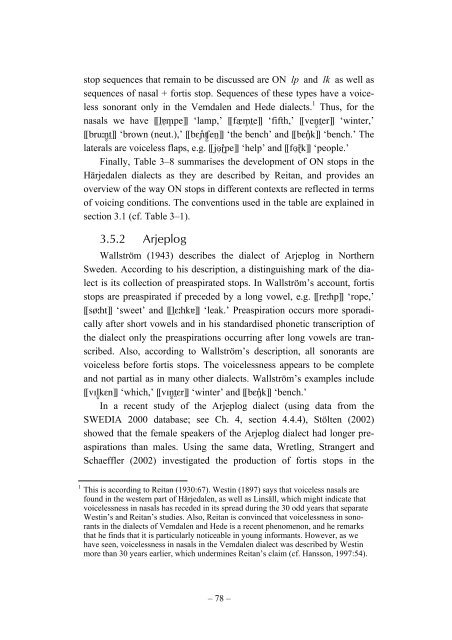Preaspiration in the Nordic Languages: Synchronic and Diachronic ...
Preaspiration in the Nordic Languages: Synchronic and Diachronic ...
Preaspiration in the Nordic Languages: Synchronic and Diachronic ...
Create successful ePaper yourself
Turn your PDF publications into a flip-book with our unique Google optimized e-Paper software.
stop sequences that rema<strong>in</strong> to be discussed are ON lp <strong>and</strong> lk as well as<br />
sequences of nasal + fortis stop. Sequences of <strong>the</strong>se types have a voiceless<br />
sonorant only <strong>in</strong> <strong>the</strong> Vemdalen <strong>and</strong> Hede dialects. 1 Thus, for <strong>the</strong><br />
nasals we have pe ‘lamp,’ fe ‘fifth,’ veer ‘w<strong>in</strong>ter,’<br />
bru ‘brown (neut.),’ be ‘<strong>the</strong> bench’ <strong>and</strong> bk ‘bench.’ The<br />
laterals are voiceless flaps, e.g. jpe ‘help’ <strong>and</strong> fk ‘people.’<br />
F<strong>in</strong>ally, Table 3–8 summarises <strong>the</strong> development of ON stops <strong>in</strong> <strong>the</strong><br />
Härjedalen dialects as <strong>the</strong>y are described by Reitan, <strong>and</strong> provides an<br />
overview of <strong>the</strong> way ON stops <strong>in</strong> different contexts are reflected <strong>in</strong> terms<br />
of voic<strong>in</strong>g conditions. The conventions used <strong>in</strong> <strong>the</strong> table are expla<strong>in</strong>ed <strong>in</strong><br />
section 3.1 (cf. Table 3–1).<br />
3.5.2 Arjeplog<br />
Wallström (1943) describes <strong>the</strong> dialect of Arjeplog <strong>in</strong> Nor<strong>the</strong>rn<br />
Sweden. Accord<strong>in</strong>g to his description, a dist<strong>in</strong>guish<strong>in</strong>g mark of <strong>the</strong> dialect<br />
is its collection of preaspirated stops. In Wallström’s account, fortis<br />
stops are preaspirated if preceded by a long vowel, e.g. rehp ‘rope,’<br />
søht ‘sweet’ <strong>and</strong> hk ‘leak.’ <strong>Preaspiration</strong> occurs more sporadically<br />
after short vowels <strong>and</strong> <strong>in</strong> his st<strong>and</strong>ardised phonetic transcription of<br />
<strong>the</strong> dialect only <strong>the</strong> preaspirations occurr<strong>in</strong>g after long vowels are transcribed.<br />
Also, accord<strong>in</strong>g to Wallström’s description, all sonorants are<br />
voiceless before fortis stops. The voicelessness appears to be complete<br />
<strong>and</strong> not partial as <strong>in</strong> many o<strong>the</strong>r dialects. Wallström’s examples <strong>in</strong>clude<br />
vkn ‘which,’ vr ‘w<strong>in</strong>ter’ <strong>and</strong> bk ‘bench.’<br />
In a recent study of <strong>the</strong> Arjeplog dialect (us<strong>in</strong>g data from <strong>the</strong><br />
SWEDIA 2000 database; see Ch. 4, section 4.4.4), Stölten (2002)<br />
showed that <strong>the</strong> female speakers of <strong>the</strong> Arjeplog dialect had longer preaspirations<br />
than males. Us<strong>in</strong>g <strong>the</strong> same data, Wretl<strong>in</strong>g, Strangert <strong>and</strong><br />
Schaeffler (2002) <strong>in</strong>vestigated <strong>the</strong> production of fortis stops <strong>in</strong> <strong>the</strong><br />
1 This is accord<strong>in</strong>g to Reitan (1930:67). West<strong>in</strong> (1897) says that voiceless nasals are<br />
found <strong>in</strong> <strong>the</strong> western part of Härjedalen, as well as L<strong>in</strong>säll, which might <strong>in</strong>dicate that<br />
voicelessness <strong>in</strong> nasals has receded <strong>in</strong> its spread dur<strong>in</strong>g <strong>the</strong> 30 odd years that separate<br />
West<strong>in</strong>’s <strong>and</strong> Reitan’s studies. Also, Reitan is conv<strong>in</strong>ced that voicelessness <strong>in</strong> sonorants<br />
<strong>in</strong> <strong>the</strong> dialects of Vemdalen <strong>and</strong> Hede is a recent phenomenon, <strong>and</strong> he remarks<br />
that he f<strong>in</strong>ds that it is particularly noticeable <strong>in</strong> young <strong>in</strong>formants. However, as we<br />
have seen, voicelessness <strong>in</strong> nasals <strong>in</strong> <strong>the</strong> Vemdalen dialect was described by West<strong>in</strong><br />
more than 30 years earlier, which underm<strong>in</strong>es Reitan’s claim (cf. Hansson, 1997:54).<br />
– 78 –

















